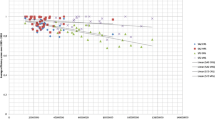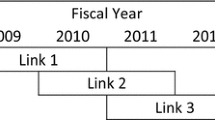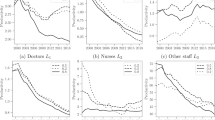Abstract
The objective of this paper is to estimate productivity changes after the inclusion of quality variables for a panel of Greek public hospitals during the period 2002–2007. We measure hospital productivity and quality changes through a non-parametric estimation of the quality adjusted Malmquist productivity index by using the percentage of survival after admissions as a proxy of hospital care services quality. Even though the empirical results indicate on average deterioration both in productivity and quality there is considerable variation among the sample hospitals.


Similar content being viewed by others
Notes
All previous studies on Greek health care efficiency (i.e., Athanassopoulos et al. 1999; Athanassopoulos and Gounaris 2001; Giokas 2001; Aletras et al. 2007; Karagiannis and Hatziprokopiou 2008; Karagiannis and Velentzas 2009) and productivity (i.e., Maniadakis and Thanassoulis 2004) measurement did not account for quality changes.
DEA as any other method has advantages and disadvantages. For a detailed discussion of these see for example the first chapter in Fried et al. (2008).
Despite the small sample size, our formulation satisfies Dyson et al. (2001) “rule of thumb”, which suggests that the number of DMUs should be greater than or equal to the double of the product between the number of inputs and the number of outputs. Otherwise, a great number of DMUs would artificially appear as efficient.
Hospitals constitute the core of the Greek National Health System. They are governed by the Chairman of the Regional Health Administration Office and are managed by the Manager and the Board of Directors.
We avoid including operational expenses as in input due to data inaccuracy. Since a large part of operational expenses consists of pharmaceuticals, there is the following peculiarity: the reported expenses as end-of-the year book values refer to that year outlays for pharmaceuticals even tough some of them have been used in previous years. This may be happen because either they were not paid in time or there was an agreement to be paid in parts. Since these details are not included in the data, it is impossible to figure out the actual annual pharmaceutical expenses from these end-of-the-year book values.
Since this is the only variable used in ratio form it means that we do not impose any a priori CRS structure in the data and consequently in the implemented model. This concerns mentioned in Jacobs et al. (2006), p. 104 arises naturally when all variables are in ratio form, with a common denominator. For this reason we can use without problems a CRS formulation (9), as required by the proper definition of the conventional and the quality adjusted Malmquist productivity indices.
As small hospitals are defined these with less than 100 beds, as medium these with 100–300 beds, and as large these with more than 300 beds.
The corresponding VRS estimates, not reported here, are as expected no less than CRS estimates.
References
Aletras V, Kontodimopoulos N, Zagouldoudis A, Niakas D (2007) The short-term effect on technical and scale efficiency of establishing regional health systems and general management in Greek NHS hospitals. Health Policy 83(2–3):236–245
Arocena P, Garcia-Prado A (2007) Accounting for quality in the measurement of hospital performance evidence form Costa Rica. Health Econ 16:667–685
Athanassopoulos A, Gounaris C (2001) Assessing the technical and allocate efficiency of hospital operations in Greece and its resource allocation implications. Eur J Oper Res 133:416–431
Athanassopoulos A, Gounaris C, Sissouras A (1999) A descriptive assessment of the production and cost efficiency of general hospitals in Greece. Health Care Manag Sci 2:97–106
Banker RD (1984) Estimating most productive scale size using data envelopment analysis. Eur J Oper Res 17:35–44
Coelli TJ (1996) A guide to DEAP version 2.1 a data envelopment analysis (Computer) program CEPA working paper 96/08. University of New England, Australia
Donabedian Α (1980) The definition of quality and approaches to its assessment. Anne Arbor, Health Administration Press, Michigan
Dyson RG, Allen R, Camanho AS, Podinovski VV, Sarrico CS, Shale EA (2001) Pitfalls and protocols in DEA. Eur J Oper Res 132:245–259
Fare R, Grosskopf S (1996) Intertemporal production frontiers: with dynamic DEA. Kluwer, Boston
Fare R, Grosskopf S, Lindgren B, Roos P (1994) Productivity developments in Swedish hospitals: a Malmquist output index approach. In: Charnes A, Cooper W, Lewin A, Seiford L (eds) Data envelopment analysis theory, methodology and applications. Kluwer, Boston
Fare R, Grosskopf S, Roos R (1995) Productivity and quality changes in Swedish pharmacies. Int J Prod Econ 39:137–147
Fixler D, Zieschang K (1992) Incorporating ancillary measures of process and quality changes into a superlative productivity index. J Prod Anal 2(4):245–267
Fried HO, Lovell CAK, Schmidt SS (2008) The measurement of productive efficiency. Oxford University Press, Oxford
Giokas ID (2001) Greek hospitals how well their resources are used. Int J Manag Sci 29:73–83
Jacobs R, Smith PC, Street A (2006) Measuring efficiency in health care: analytic techniques and health policy. Cambridge University Press, UK
Karagiannis R, Hatziprokopiou M (2008) Measuring and explaining technical efficiency of Greek public hospitals. Empir Econ Lett 7(1):17–23
Karagiannis R, Velentzas K (2009) A comparison of alternative parametric efficiency estimates using rank-sum test statistic. Int J Comput Econ Econom 1(2):195–209
Laine J, Finne-Soveri H, Bjorkgren M, Linna M, Noro A, Hakkinen U (2005) The association between quality of care and technical efficiency in long-term care. Int J Qual Health Care 17(3):259–267
Maniadakis N, Thanassoulis E (2004) A cost Malmquist productivity index. Eur J Oper Res 154:396–409
Maniadakis N, Hollingsworth B, Thannasoulis E (1999) The impact of the internal market on hospital efficiency, productivity and service quality. Health Care Manag Sci 2:75–85
Prior D (2006) Efficiency and total quality management in health care organizations a dynamic frontier approach. Ann Oper Res 145:281–299
Sola M, Prior D (2001) Measuring productivity and quality changes using data envelopment analysis an application to Catalan hospitals. Financ Account Manag 17(3):219–245
Valdmanis V, Rosko M, Mutter R (2008) Hospital quality, efficiency and input slack differentials. Health Serv Res 43(5):1830–1848
Acknowledgments
Pythagoras II-Funding of research groups in the University of Macedonia, Priority Action 2.2.3.e, Measure 2.2, to be implemented within the framework of the Operational Programme “Education and Initial Vocational Training II (EPEAEK II)” and co-financed by the European Union [3rd Community Support Framework, 75% financed by the European Social Fund 25% National Resources].
Author information
Authors and Affiliations
Corresponding author
Appendix: Linear programming problems
Appendix: Linear programming problems
Similar for [D t+1 oc (x t+1, y t+1, α t+1)]−1 = max ϕ
Rights and permissions
About this article
Cite this article
Karagiannis, R., Velentzas, K. Productivity and quality changes in Greek public hospitals. Oper Res Int J 12, 69–81 (2012). https://doi.org/10.1007/s12351-010-0080-4
Received:
Revised:
Accepted:
Published:
Issue Date:
DOI: https://doi.org/10.1007/s12351-010-0080-4




